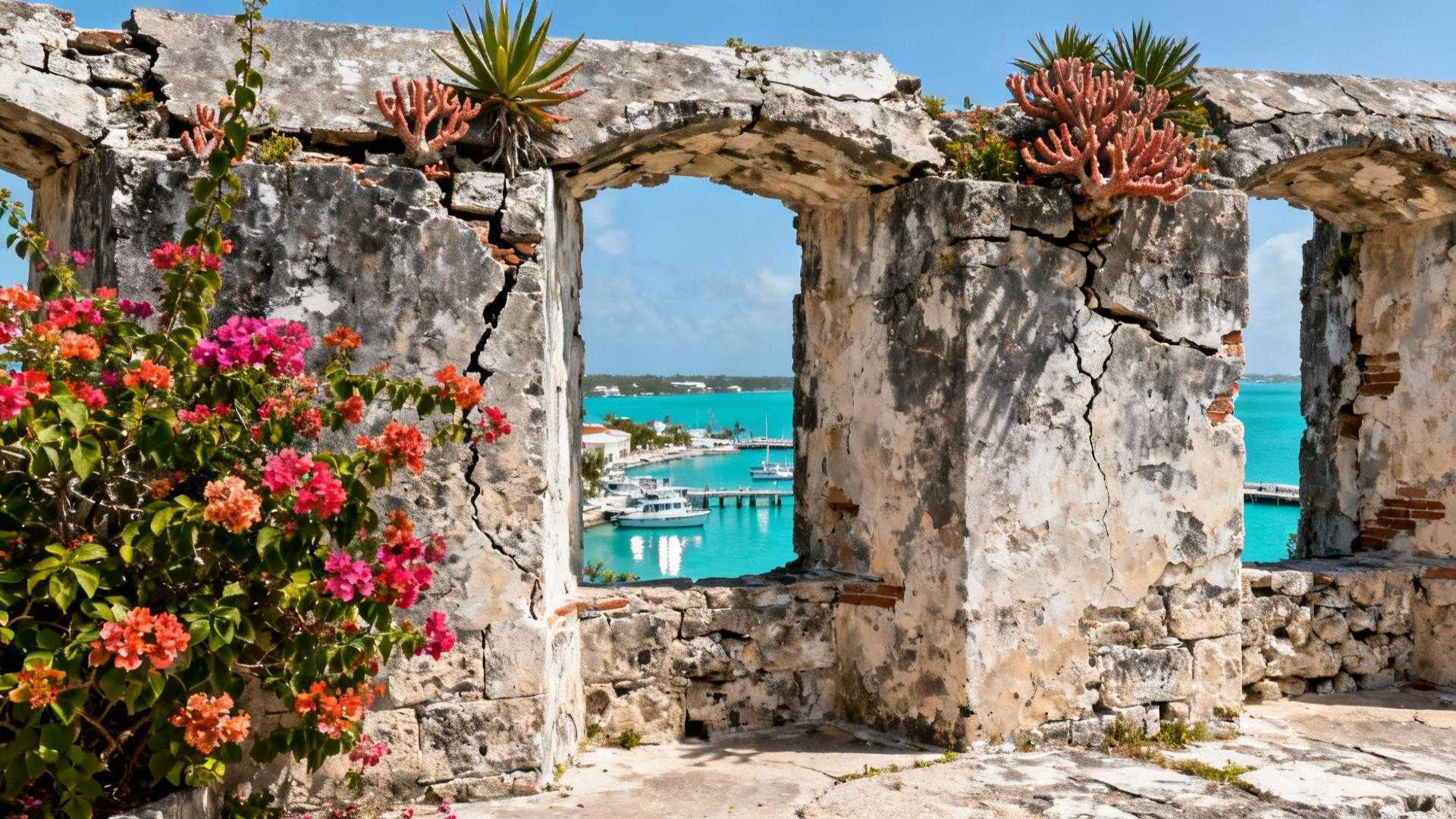I stood on the crumbling limestone ramparts of Castle Island as waves crashed against rocks where Spanish cannons once aimed at English gunners. The fortress walls, built in 1612, held a secret that changed how I understood early American colonial history. This wasn’t just another Caribbean fort—it was the oldest surviving English stone fortification in the New World, and locals call it the forgotten sentinel for good reason.
King’s Castle anchors Bermuda’s eastern defenses in Castle Harbour, a small island fortress that witnessed the only Spanish military attack on Bermuda in 1614. Two cannon shots fired from these walls convinced Spanish ships to retreat, though the defenders held just one cannonball remaining. That bluff saved Bermuda from invasion and established this fortress as a symbol of early English colonial resilience.
Unlike heavily visited Caribbean forts crowded with cruise ship tourists, Castle Island remains eerily abandoned. Overgrown vegetation reclaims stone walls where British soldiers lived during World War II, their machine gun positions still visible among 17th-century battlements. This is the exclusive colonial relic that architectural heritage enthusiasts overlook, hidden in plain sight despite its UNESCO World Heritage Site status.
The 1612 fortress that predates American colonial landmarks
Why King’s Castle claims historical supremacy
King’s Castle was constructed under Governor Richard Moore’s direction as part of the Virginia Company’s strategic fortification network. While jamestown settlers struggled with survival in Virginia, Bermudian colonists built permanent stone defenses that still stand intact today. The fortress predates Plymouth Rock by eight years and represents English colonial ambition materialized in Bermuda limestone and imported stone.
The Captain’s House: America’s oldest English residence
Adjacent to the main fortress stands the Captain’s House, built in 1621—one year after Bermuda’s State House. This structure holds dual distinction as both the oldest stone home in Bermuda and the oldest standing English house in the New World. Its limestone walls sheltered military commanders who orchestrated harbor defenses across four centuries, from Spanish threats to World War II submarine watches.
The 1614 Spanish attack that never returned
How three cannonballs defeated an invasion fleet
When two Spanish ships approached Castle Harbour in 1614, King’s Castle’s gunners faced a critical ammunition shortage. They possessed only three cannonballs total—enough for two warning shots with one desperate reserve. The English fired twice, missing both times, but the show of force convinced Spanish commanders to withdraw. They never discovered how close they came to finding the fortress defenseless, and Spain never attempted another Bermuda invasion.
The broader Spanish colonial context
Spanish interest in Bermuda dated to Juan de Bermúdez’s 1515 visit, though dangerous reefs and hurricanes earned the island the nickname “Demoniorum Insulam”—Island of Devils. Spanish galleons regularly passed Bermuda following Gulf Stream currents homeward from the Americas, but avoided landing. The 1614 attack represented Spain’s only serious attempt to challenge English control, making King’s Castle’s successful defense historically unique across Caribbean colonial conflicts.
The fortress network that protected Castle Harbour
Five centuries of evolving military architecture
Castle Island anchored a comprehensive defensive system including Devonshire Redoubt (1620), Southampton Fort on Brangman’s Island, and Charles’ Fort on Goat Island. This network created overlapping fields of fire across Castle Harbour’s southern entrance, forcing any approaching vessel into multiple kill zones. The strategic distribution demonstrated sophisticated English colonial military planning that protected Bermuda through three centuries of European conflicts.
World War II’s machine gun sentinel
British garrison soldiers lived in tents within King’s Castle’s ancient walls during World War II, mounting machine guns to monitor strategic channels. These 20th-century defenders occupied the same limestone battlements their 17th-century predecessors built, creating a remarkable continuity of military purpose. The juxtaposition of colonial-era stonework and modern weapons emplacements makes Castle Island archaeologically unique among Atlantic fortifications.
Why locals protect the forgotten sentinel
Preservation challenges and restricted access
Castle Island’s abandoned status serves conservation purposes—limited tourist access prevents the degradation affecting heavily visited Caribbean forts. Salt corrosion and tropical vegetation threaten the limestone structures, but natural overgrowth actually stabilizes ruins while deterring casual visitors. Bermuda National Trust manages the site with strict access policies, unlike reconstructed colonial sites that prioritize tourism revenue.
The archaeological mysteries still buried
Unexplored sections of Castle Island hold artifacts from four centuries of military occupation. Archaeologists periodically discover colonial-era cannonballs, British military equipment, and structural evidence of fort expansions. The site’s isolation preserved materials that scrap metal industries destroyed at other Caribbean locations, making King’s Castle invaluable for understanding early American colonial military architecture.
Common questions about Castle Island access
How do I reach the fortress ruins?
Castle Island requires boat access from St. George’s, Bermuda’s historic eastern settlement. Private boat charters operate seasonally from April through October, offering guided tours that respect preservation zones. Check current Bermuda National Trust policies before planning visits, as access restrictions change based on conservation needs and weather conditions.
What makes King’s Castle historically unique?
King’s Castle represents the oldest surviving English stone fortification in the New World, predating all mainland American colonial forts. Its successful defense against Spanish attack in 1614 marks the only military assault Spain attempted on Bermuda. The fortress complex includes structures spanning 1612 to World War II, creating an unparalleled timeline of English colonial and British military architecture.
Can I visit during hurricane season?
Hurricane season (June through November) limits safe boat access to Castle Island. Plan visits between April and October for optimal weather and operational tour services. Spring visits coincide with Bermuda’s National Heritage Festival in May, offering enhanced cultural context for understanding the fortress’s historical significance.
The forgotten sentinel guards more than harbor entrances—it protects four centuries of English colonial history that shaped the New World. King’s Castle’s limestone walls witnessed the earliest American colonial military engagement, survived countless Atlantic storms, and continue standing as the oldest English fortification in the Americas. This isn’t heritage reconstructed for tourists; it’s authentic history preserved through careful neglect, waiting for respectful travelers who value cultural stewardship over Instagram crowds.
